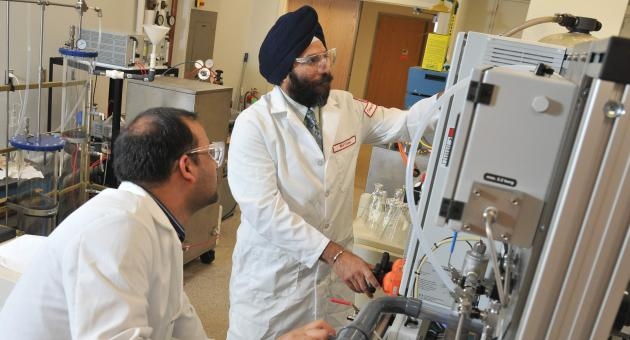New wastewater treatment developed at Temple is more effective and environmentally friendly

A new novel adsorbent for removing emerging contaminants from wastewater that is more effective, reusable and environmentally friendly, has been developed by researchers in Temple University’s Water and Environmental Technology (WET) Center.
The researchers used cyclodextrins, a family of compounds made up of bound glucose (sugar) molecules, to develop their adsorbent material, which could have a positive impact on the water treatment, pharmaceutical, chemical and manufacturing industries, said Rominder Suri, professor of civil and environmental engineering and director of the WET Center in Temple’s College of Engineering.
Suri said that cyclodextrins have an affinity for attracting organic compounds that is much higher than activated carbon, which is currently the most commonly used material by industry for removing wastewater contaminants.
“Activated carbon is very porous and water — whether it be surface water, groundwater or wastewater — contains a lot of natural organic matter,” said Suri. “These are big molecules and when they hit the activated carbon, they block the pores which prevent the contaminant particles from getting inside.”
Suri said the new adsorbent has a cavity-like area in which they can trap the contaminants, which are made up of organic compounds. By changing the functional groups on the glucose molecule, the size of the cavity can be increased or reduced.
“That means is we can potentially manipulate this adsorbent substance to target and remove select contaminants, something that activated carbon cannot do,” he said.
Although cyclodextrins are soluble, meaning they dissolve easily in water, the new adsorbent has been made insoluble by the Temple researchers and can easily be attached as a thin coating to such surfaces as sand, glass, silica and filter paper.
So far, the researchers have tested the new adsorbent material against contaminants such as steroid hormones, detergent compounds and bisphenol A in both lab water and discharged wastewater and found that it has removed more than 90 percent of the contaminants, said Suri.
“This new adsorbent material has much less surface area than activated carbon, especially if you coat it on sand,” he said. “But our results demonstrate that it has comparable, or even better, capacity than the activated carbon. And, it has the potential to be even more efficient by coating it on porous, high surface materials.”
In addition to its effectiveness in removing contaminants, Suri said that the new material’s other benefit is that it can easily be regenerated and reused. A solvent such as methanol can be used to remove the contaminants or ozone can be used to destroy the trapped contaminants, both allowing the adsorbent material to be reused.
So far, the researchers have tested several batches of the adsorbent material through four different cycles (use, clean, reuse) and it continues to work with the same effectiveness, said Suri.
“Activated carbon is one and done,” he said. “In industry, once it has been used it will be either landfilled or it can be reactivated through a very energy-intensive and expensive process.”
Suri said the next step for the new adsorbent material is to do more extensive pilot testing.
The research into cyclodextrins was funded by the National Science Foundation (NSF) and the translational development of that research into an adsorbent is being supported through the NSF-funded Water Technology Innovation Ecosystem established at Temple’s WET Center in 2011.